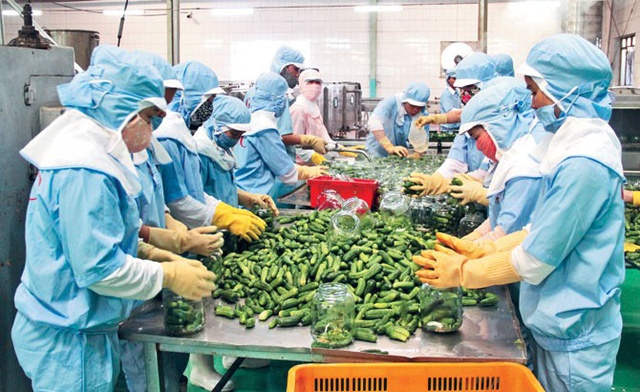Agricultures, Foods, News & Event
Opportunity for agricultural products to conquer the market of billions of people
China is opening up more widely with many kinds of agricultural products officially imported from Vietnam. To effectively exploit this market of billions of people, the domestic agricultural production industry needs to standardize the process to meet the needs of importers.

Increase your chances
In just a short time, there have been 3 types of Vietnamese agricultural products that China agreed to import officially, the latest is sweet potato and bird’s nest, before that is durian. At the same time, passion fruit is also piloted through a number of designated border gates from July 2022.
Up to now, Vietnam has 13 types of agricultural products officially exported to China (including: dragon fruit, longan, rambutan, mango, jackfruit, watermelon, banana, mangosteen, litchi, durian, passion fruit, potato, etc. lang, bird’s nest).
Never before has the opportunity for our country’s agriculture sector been so great, when major consumer markets such as the US, Europe, Japan, China… have all opened doors to import Vietnamese goods. The remaining problem in order to accelerate exports, increase value and position soon, is none other than that the domestic manufacturing industry must move, produce in a systematic and methodical manner, strictly follow each stage, each step. the link set by the importer.
The production capacity of fresh fruits, vegetables – vegetables – processed fruits of our country is increasing, reaching a peak value of nearly 4 billion USD in a year, of which China accounts for 55 – 60%.
Contacting the Japanese market, Ms. Nguyen Ngoc Huyen, CEO of Mia Group (an enterprise specializing in the import and export of high-quality agricultural products and fruits) shared: “We like to think that Japan is a difficult market. , if the goods meet the requirements of Japanese customers, it will be convenient to enter other markets. Therefore, Vietnamese businesses also need to conquer Chinese customers like other fastidious markets.”
Ms. Huyen analyzed that the demand for fresh fruit in this market is very large, as long as domestic enterprises can take advantage of a part of it, they will not have to worry about lack of places to consume, but it is necessary to standardize the production process. export.
“I just attended the leading international trade fair for fresh fruit products in the Asia-Pacific region, meeting hundreds of buyers in the agricultural sector around the world. Chinese businesses, after viewing the Vietnam Fruit Map with full information on the growing area, output and production process, have “closed” a number of orders for the 2023 crop,” Huyen informed.
It can be seen that when a supplier guarantees standard sales, daring to “nod” to the strict requirements of the buyer, that is, implicitly sending a message: exported goods meet quality standards.
In addition to seasonally exported fresh fruit, there are enough facilities for licensed growing areas, clear traceability, and qualified packaging facilities, if enterprises invest in a competitive processing plant system raw material areas, will be the “address” to consume a large amount of agricultural products, both helping to improve value and not worrying about price pressure.
Big space
Each year, China spends about 15-17 billion USD importing vegetables and fruits. This is a space for Vietnam’s fruit and vegetable industry to increase exports as the production process is increasingly standardized and professionalised.
In addition to fresh and processed vegetables, looking at the newly exported bird’s nest products, it can be seen that the ability to increase export value will soon be realized. According to the Department of Livestock Production (Ministry of Agriculture and Rural Development), Vietnam’s bird’s nest industry has many development opportunities and potential to bring high economic value.
The whole country currently has 22,087 bird nest houses, the output of oats is over 120 tons, worth about 450 million USD, while the demand for importing bird’s nests of China is very large. The fact that this market is open to official import of bird’s nests is the motivation for enterprises to invest in large-scale and more concentrated production. Accordingly, this item is also expected to soon enter the list of billion-dollar export commodity groups of the agricultural industry.
It is a fact that the mindset of considering China as an “easy” market has been deeply rooted in many Vietnamese businesses, so many businesses have not really invested properly to conquer this market. However, in recent years, more and more enterprises have attached importance to the Chinese market such as the US, EU markets, etc., through a synchronous investment strategy in raw material areas, deep processing, traceability, and export. origin, to conquer the market of billions of people.
As for the dairy industry, dozens of factories have been granted export transaction codes, including big names such as Vinamilk, TH True Milk, Moc Chau Milk, Nutifood, and Hanoimilk.
According to the Import and Export Department (Ministry of Industry and Trade), exporting agro-forestry-fishery products to China has advantages not only thanks to its close distance, low transportation costs and large market capacity, but also thanks to the system of FTAs are being implemented, tariff preferences also bring significant benefits to businesses.
Specifically, implementing commitments in the ASEAN-China Free Trade Agreement, up to now, China has reduced taxes on more than 8,000 items imported from Vietnam, including agricultural products and fresh fruits. many opportunities for Vietnamese businesses to access this large market.
Source: https://baodautu.vn/co-hoi-de-nong-san-chinh-phuc-thi-truong-ty-dan-d177934.html
